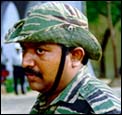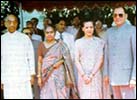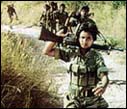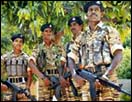The Rediff Special/J N Dixit
'Prabhakaran said he did not trust either RAW or the ministry of external affairs'
 The various Tamil groups and the LTTE were not fully satisfied
with the Agreement. Prabhakaran told Rajiv Gandhi in the initial
stages of his discussions with the latter that he did not know
that India was going to sign the Agreement. He thought that India
would finalise the draft and submit it to the Tamil groups, especially
the LTTE, which in turn would sign the Agreement with the Sri
Lankan government after appropriate negotiations.
The various Tamil groups and the LTTE were not fully satisfied
with the Agreement. Prabhakaran told Rajiv Gandhi in the initial
stages of his discussions with the latter that he did not know
that India was going to sign the Agreement. He thought that India
would finalise the draft and submit it to the Tamil groups, especially
the LTTE, which in turn would sign the Agreement with the Sri
Lankan government after appropriate negotiations.
India originally
thought that Sri Lankan Tamils should be signatories to such an
agreement. Rajiv Gandhi pointed out that this was his original
message to Sri Lanka and to the Tamil groups. He then pointed
out that it was the LTTE which stressed that the Agreement should
be signed between India and Sri Lanka. Prabhakaran had no answer.
He assumed an ambiguous stance.
Prabhakaran made a serious of demands for an immediate follow-up,
once the Agreement was signed. He wanted Sri Lankan government
forces of all categories to pull back from the whole of the North
and Eastern Provinces. He wanted management of the law and order
handed over entirely and immediately to his cadres. He was not
happy about the tentative provision for holding a referendum on
the merger of the Northern and Eastern Provinces by the end of
1988.
He wanted the merger to be declared permanent and irrevocable.
He not only wanted all Tamil refugees in India as well as within
Sri Lanka to be resettled and rehabilitated, but the Sinhalese
people in north-central Sri Lanka, settled there since
the mid-fifties under the Mahaveli colonisation schemes, to be
uprooted and replaced by Tamils.
 Even the moderate Tamil political party, the TULF, in a communication
to Rajiv Gandhi immediately after the signing of the Agreement
articulated somewhat similar demands. Prabhakaran, while generally
agreeing to the surrender of arms, demanded that he and his senior
leaders should be allowed to retain their arms for personal protection,
a suggestion which was accepted by the Sri Lankan and Indian authorities.
Even the moderate Tamil political party, the TULF, in a communication
to Rajiv Gandhi immediately after the signing of the Agreement
articulated somewhat similar demands. Prabhakaran, while generally
agreeing to the surrender of arms, demanded that he and his senior
leaders should be allowed to retain their arms for personal protection,
a suggestion which was accepted by the Sri Lankan and Indian authorities.
Prabhakaran was flown back to Jaffna as promised by Rajiv Gandhi
on August 2. He had already indicated that a ceremonial surrender
of arms would take place on August 4 and 5. Rajiv Gandhi insisted
that the surrender of arms should not be described as 'surrender'.
I had messages suggesting that the whole exercise should be described
as: 'laying down of arms by LTTE in the larger interests
of the peace and well-being of the Sri Lankan people,' a
suggestion which was readily agreed to by Jayewardene.
The most significant event in Jaffna immediately after the signing
of the Agreement and the arrival of the Indian Peace Keeping Force
was a large public meeting which Prabhakaran on August 4, on
the grounds of the Sudumalai Temple. His speech was militant and not
fully supportive of the Agreement. He said he had agreed to generally
endorse the Agreement only on the insistence of the Government
of India and because India had always been a source of strength
and support to the Tamils. The Agreement did not fulfill all the
Tamil aspirations.
While he had agreed to the contents of the
Agreement, he reserved his options for the future course of action
on the basis of his assessment of how the Agreement was actually
implemented. His endorsement of the Agreement did not mean abandonment
of the basic Tamil demand for Eelam which he had been advocating
over a period of time.
The tone and content of the speech was totally contrary to the
commitments he had given to M G Ramachandran and Rajiv Gandhi in
Delhi. The text of the speech and its translation reached me late
at night. I immediately requested my Sri Lankan Tamil contacts
in Jaffna to find out what Prabhakaran's motivations and plans
were in the light of the speech he made. The response I got was
that he had generally endorsed the Agreement because he considered
good relations with the government and people of India vital to
the Tamil cause. He, however, had some reservations which he had
to articulate.
 He said the second reason for the tone of his speech
was because he had to carry Sri Lankan Tamil public opinion with
him. He could not be seen abandoning his entire set of demands
including the establishment of Tamil Eelam. That was why he hedged
his commitments regarding the Agreement. I was informed that the
surrender of arms would take place as scheduled and that he would
remain in close touch with the headquarters of the IPKF.
He said the second reason for the tone of his speech
was because he had to carry Sri Lankan Tamil public opinion with
him. He could not be seen abandoning his entire set of demands
including the establishment of Tamil Eelam. That was why he hedged
his commitments regarding the Agreement. I was informed that the
surrender of arms would take place as scheduled and that he would
remain in close touch with the headquarters of the IPKF.
The arms surrender ceremony took place on August 5 in Jaffna.
Defence Secretary Cepalle Attygalle, senior representatives of
the Sri Lankan Red Cross, the district officer in charge of Jaffna
and General Harkirat Singh of the IPKF represented Sri Lanka and
India respectively. Significantly, Prabhakaran did not come to
the ceremony to lay down arms. He sent the then political advisor
to his high command Yogi along with Mahatya and Balasingham.
Prabhakaran
explained later that he did not himself come for the ceremony
because he was concerned about his security. It was, however,
obvious that his absence at the ceremony was also a political
gesture of reservation and withdrawal, which both India and Sri
Lanka took note of.
 Prabhakaran had met Lt General Depinder Singh,
GOC, Southern Command, before he returned to Jaffna. Lt General
Depinder Singh later revealed that Prabhakaran told him (General
Singh) that he did not trust either the Indian Research and Analysis
Wingh or the ministry of external affairs. He hoped that the Indian
Army would stand by Tamils now that it was in Sri Lanka. I cannot
confirm the authenticity of this report, but this conversation
has been mentioned partly in General Singh's memoirs and partly
by some Sri Lankan authors who had written about Indo-Sri Lanka
relations during this period.
Prabhakaran had met Lt General Depinder Singh,
GOC, Southern Command, before he returned to Jaffna. Lt General
Depinder Singh later revealed that Prabhakaran told him (General
Singh) that he did not trust either the Indian Research and Analysis
Wingh or the ministry of external affairs. He hoped that the Indian
Army would stand by Tamils now that it was in Sri Lanka. I cannot
confirm the authenticity of this report, but this conversation
has been mentioned partly in General Singh's memoirs and partly
by some Sri Lankan authors who had written about Indo-Sri Lanka
relations during this period.
Excerpted from Assignment Colombo, by J N Dixit, Konarak Publishers, 1998, Rs 400, with the publisher's permission.
Readers interested in obtaining a copy of the book may direct their enquiries to Mr K P R Nair, Konarak Publishers, A-149, Main Vikas Marg, New Delhi 110 001.
Tell us what you think of this feature
|



